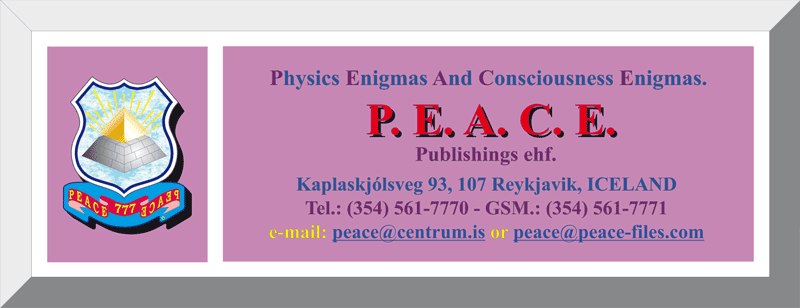 |
The Physics Enigmas And Consciousness Enigmas Files "The PEACE-Files" P. E. A. C. E.
|
| The
Contents
of the Prophesied
Book: "THE LITTLE SCROLL" Following are the contents of a seven part book presenting the worlds first models for a complete quantum mechanical and molecular biological theoretical paradigm of unification. This is claimed as: "The Ultimate Theory of Everything" Although the
Subject of the
Book takes References in Religious Prophesies, it is not Religion
Oriented. |
| 00 : Introductions | The Presentation of the Book. |
| 01 : The Preface | The Introduction of the Book's Foundat- ions. |
| 02 : The Premises | The Spiritual Justification for the Book. |
| 03 : Part One 1 | Introduction to the Cutting Edge of Theo- retical Physics and its Approach to the Theory of Everything. |
| 04 : Part One 2 | Introduction to the Venn-set Theoretical Approach to the Theory of Everything. |
| 05 : Part Two 1 | The Venn-set Theoretical Models for the Process during the Creation of Time and the Quantum Wave of the Universe. |
| 06 : Part Two 2 | The Venn-set Theoretical Models for the Creation of Mass during the First Second of Time. |
| 07 : Part Three 1 | The Initial Connection of the Venn-set QF-Theory of Everything, to the Standard Model of Physics. |
| 08 : Part Three 2 | The Initial Connection of the Venn-set QF-Theory of Everything to Life, the Human Brain and Consciousness. |
| 09 : Epilogue | The Initial Philosophical Conclusions and Bibliography. |
To Home-Index-Front-Page
Part One

“But there was no one
in Heaven
or on Earth,
or in the World below who
could open the
Scroll and look inside
it.”
On
the Subject of the Writings in this Book
"There
are two revelations in reality; the first is given to us in scripture
and
tradition, and it guided our thinking for centuries. The second
revelation
is given by the Universe, and that book we are just beginning to read."
Sir Francis Bacon 1561-1626
The Final Quest of Man's Knowledge
The Bible of King James;
The Book of Revelation 52-7
"Behind
it all is surely an idea so simple,
so
beautiful, so compelling that when–in a decade,
a
century or a millennium–we grasp it,
we
will all say to each other;
How
could it be otherwise?
How
could we have been so stupid for so long?"
John Archibald Wheeler
Part One,
Chapter
One
The
Last
Enigmas
of Man
The
Ultimate Questions in
the
Sciences of Physics and Biology
"The question of all questions for humanity, the problem which lies behind all others, and is more interesting than any of them, is that of determination of Man’s place in Nature and his relation to the Cosmos."
Henri Poincaré
History’s Most Exciting Detective Story.
At the beginning of our recorded history we find the question and answer game being undertaken primarily by religious sages and prophets and later by individuals which were called nature, or religious philosophers, with the original meaning of the Greek word denoting something like: “Lover of knowledge and wisdom.”
During the latter part of the Middle Ages, particularly after the beginning of the Renaissance, and during the last four centuries of the Enlightenment, many of the engagements of the philosophers evolved into what we today know as the different disciplines of the sciences. The past two centuries have in particular seen these evolve into numerous highly specialized branches of inquiry. In continuation of this, the 20th century then saw specialization reaching what many regard as extreme, with some of the lesser philosophical and theological speculations of the ancient thinkers turning into hard core scientific investigations. However, during the latter half of this century, the oddity in this trend has been the tendency of some of the more sophisticated disciplines to approach each other and eventually to reunite. This is not taking place due to some ideology of the scientists, but due to the nature of the subjects of investigation. In this the scientists have become aware that they are in fact trying to solve the same questions, by different routes. This reunification process has primarily been lead by the convergence of theoretical physics, cosmology, astrophysics and high-energy particle physics. Today, it may be said that it is centered on what is now known as the Standard Inflationary Model of the Big Bang and the Standard Model of Elementary Particles. These two models have become so interdependent, that one can speak of just one model, ‘The Standard Model’. Although some, for several reasons, have demanded the inclusion of the Observer into The Standard Model, this has proven too complex.
It is this theoretical model of the Universe, ‘The Standard Model’, and the inclusion of Man, which is the subject of these writings. As regards the proceedings of the sciences, the prime excitement regarding The Standard Model is the question whether this will, through its further evolution, provide the ultimate answers about everything. The theorization dealing with the first part of the Universe’s First Second of Creation suggest a moment where all the forces of nature are united into one. As explained in the beginning of this book this is known as complete unification theory, or CUT for short. A fraction of a second later, gravity separates from the other forces and the unification that then prevails for another fraction of a second, is described by physicists in grand unification theories, or GUTs for short. With the achievement of a Complete Unified Theory that includes Life and the Observer’s consciousness, the QF-theory becomes a final Theory of Everything, or TOE for short.
The briefest
possible
History of Time.
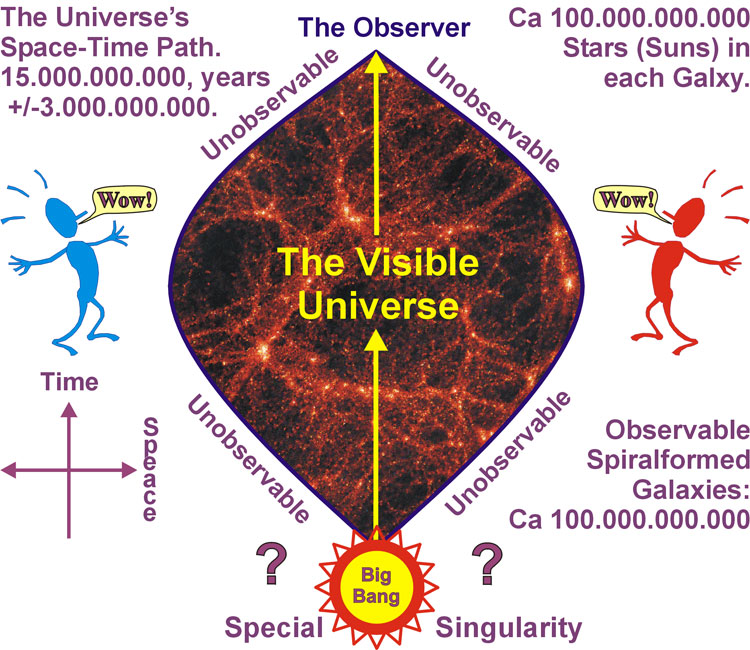 |
Figure 006
What are the Main Enigmas of this Detective Story?
The Big Bang, or whatever we choose to call it, comprises the moment of the beginning of our creation. This did not take place, when our parents got together to contribute a half each of a genome, but some 5 x 1017 seconds ago. The First Second of Creation is not only the time of the creation of the fundamental constituents of matter, but also the initiation of the process for the creation of our bodies, brains and consciousness which we are made of. The reading of this book should show the reader that the laws for our creation are indeed written at that “time”. In the next chapter, we shall be looking closer at the story of the quantum mechanical science of creation in the 20th century, but here we shall be looking at the prime questions and enigmas involved.
In the past two decades a flood of books on the subject of the search for the first and foremost fundamental truths of Nature, has become available to the public where this difficult subject is being explained by many a brilliant scientist and science writer. As this is written, some of our physicists are telling us that they are situated on a crossroad on their way to the final answer. This is not only the problem with the higher energies of the accelerators, but problems which are further confounded by the difficult decision on which road to take. This has to do with selection and creation of conceptual approaches in the face of encroaching limitations of the mathematical and technical methods. In whatever form the ultimate findings may be, they are now being described as the Theory of Everything. Consequently, these writings begin with a brief overview of the prime targets in the search of humanity for the Theory of Everything, what this search is all about as it concerns physics and humanity at large. Following are some points, taken from some of the leading physicists, regarding the challenges involved in the final understanding of the Universe.
We begin by quoting Kitty Ferguson in her enlightening 1991 book STEPHEN HAWKING, QUEST FOR A THEORY OF EVERYTHING where she asks: “What would a theory to explain the universe be like?” Kitty calls the prime questions: “Challenges for Theory of Everything candidates!” Here they are:*
01) “It must give us a model that unifies the forces and particles.”
02)
“It
must
answer the question, What are the ‘boundary conditions’ of the
universe,
the conditions at the very
instant of beginning, before any time
whatsoever
passed?”
03)
“It
must
allow few options. It ought to be ‘restrictive.’ It should, for
instance,
predict precisely how many types
of particles there are. If it leaves
opinions,
it must somehow account for the fact that we have the universe we
have
and not a slightly different one.”
04)
“It
should
contain few arbitrary elements. Paradoxically, the Theory of Everything
itself may be an arbitrary
element.”
05)
“It
must
predict a universe like the universe we observe or else explain
convincingly
why there’s a
discrepancy... A Theory of
Everything must
find
a way to survive comparison with what we observe.”
06) “It should be simple, although it must allow for enormous complexity.”
07)
“It
must
solve the enigma of combining Einstein’s theory of general relativity
with
quantum mechanics...
Both general relativity and quantum
mechanics are
exceptionally good theories,... Nevertheless, put together
they yield infinities and nonsense. The Theory of
Everything must
somehow
resolve that nonsense.”
Ferguson reminds us of Hawking’s question: “Why does the universe go to all the bother of existing?”* which is in fact a part of the question that started the author’s adventure into this field. Ferguson further reminds her readers that: “The Theory of Everything will be a set of laws that make it possible to predict events up to the limit set by the uncertainty principle, and that means in many cases we will have to satisfy ourselves with statistical probabilities, not specifics.”*
As a continuation of this she further reports that: “Stephen Hawking sums up our problem. In answer to the question whether everything is predetermined, either by the Theory of Everything, or by God, he says, Yes he thinks it is. ‘But it might as well not be, because we can never know what is determined.’”* However, that is something the author dares challenge in this book. It may even be stated that the central theme of this book is to show how its creation is predetermined.
In a most excellent book, Dr. F. David Peat discusses extensively the main problems facing the late twentieth century emerging superstring theories (pages 51-53) and sums these up by the suggestion that some sort of a “superstring field concepts” are needed as a final theory. From Dr. F. David Peat’s book SUPERSTRINGS AND THE THEORY OF EVERYTHING are noted the following questions:
01)
What
are the elementary particles?
02)
What
is mass?
03)
Why
are there four forces in nature?
04)
What
are the symmetries of the elementary particles?
05)
Why
is our space three-dimensional?
06)
Why
is the cosmological constant zero?
07)
What
is the relationship between relativity and quantum theory?
The Overview
Situation
of Theoretical and Experimental
Physics at the
End of the Twentieth Century.
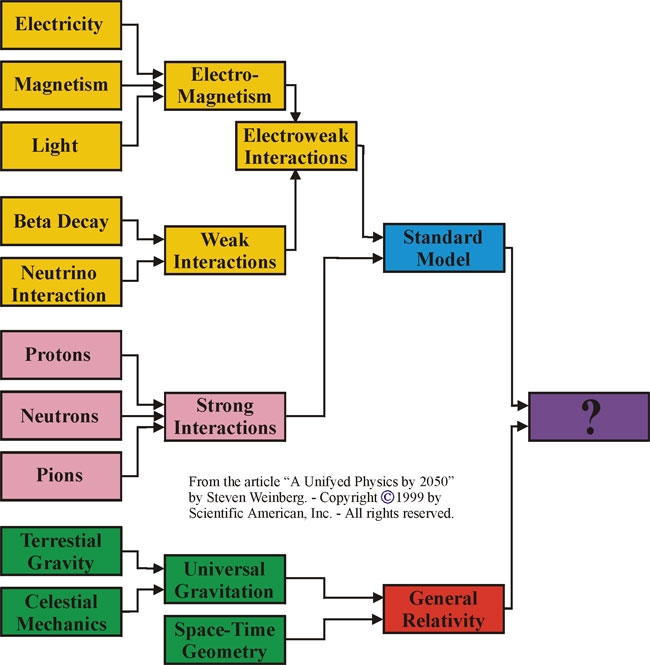 |
Figure 007
The Overview History of Theoretical Physics
at the End of the Twentieth Century.
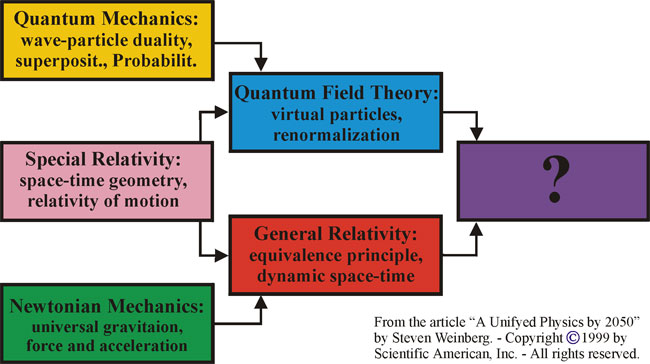 |
Achievement, and Verification of a Final Theory.
This
specific
time
is a part of the First Second of Creation
that is known as the GUT ERA
(Grand Unification Era) and it is the simplicity of that moment that is
sought to be captured. It is during this time, that the nature of what
is taking place can only be described in the terms of quantum
mechanics.
It is here that the birth of time is completed. This is the moment of
the “first
quantum-wave of the Universe”. At this second fraction,
the program for all consequent wave functions was written, and this in
turn includes the present wave function of the consciousness of the
human
brain. It may thus represent the very program for the ultimate reality
of the Universe, as it is perceivable by the human brain. Eventually,
this
may include the answers to all questions about life, and the value of
this
alone may turn out to be immeasurable, particularly if it contributes
to
the destruction of some of Man’s long standing arguments regarding
reality.
In particular such seemingly endless differences as the oldest and
bloodiest
argument of Man; The argument about God. A concept that according to
the
religions is one that should be uniting Men, not drive them asunder.
The
reference is primarily in regard to religious, ethnic, economic and
political
differences, as well as the possibility of it bringing solutions to the
numerous functional malfunction disorders of the human brain.
The current state
of affairs in Man’s effort at solving the final questions in physics is
beginning to indicate problems with the methods used to understand
nature.
This is brought on by the fact that the magic of mathematics seems to
be
insufficient in dealing with the final understanding of gravity.
Another
problem makes the subject further of extraordinary nature, but this is
the fact that according to the methods and requirements of physics, the
QF-theory
may forever remain, just theorizations, since the nature of the subject
is such that no direct experimental proof may ever be attainable. The
energies
required would be far to high for any direct experimentation. This is
to
many physicists a dreaded nightmare, since it may ultimately leave them
with nothing to turn to but philosophy in the form of the Anthropic
Principle. This refers to a statement that says
everything
is as it is because we are as we are. – This book deals with the
problems
that have been described here briefly, approaching them with an
alternative
approach, an alternative mathematical method. This is known as
set-mathematics
and the particular method used has been dubbed: The QREST-FIELD,
or QF-approach. However,
the QF-theory
is not mere speculations since it attempts to follow as closely as
possible–and
is for the most part in agreement with–the existing theories of the
worlds
leading physicists.
Particle
Masses,
Accelerator Energies and Unification.
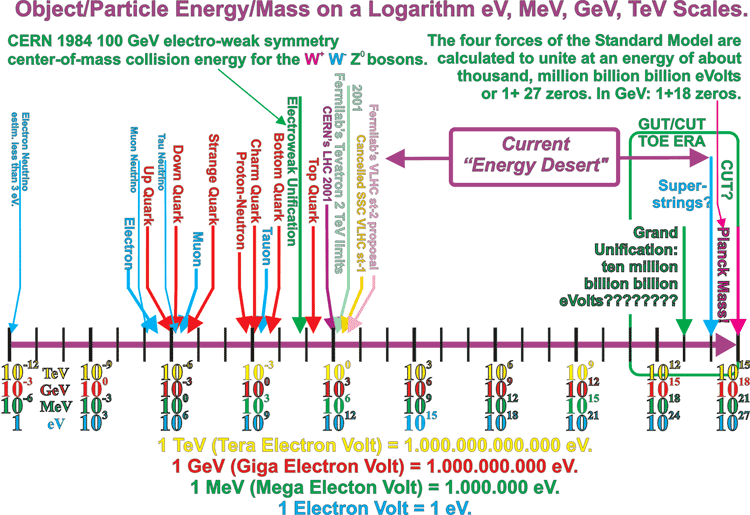 |
Figure 009
Close comparison to the theories and experimental findings of physics have thus served to keep the author’s creative thinking in check. Here a special danger is involved in the symbolic logic of the QREST-FIELD approach, since these deal in extreme simplicity and provide a form of visual images of thinking, something which mathematical processes and equations cannot do. The QF-system is thus a form of pictorial mathematics, which achieves such simplicity that it may be dubbed “mathemagics”. This should, however, not be understood to mean that the method can provide a true picture of the quantum particles. These are as elusive as ever. The system is purely a symbolic language of logic, which does not deal in magnitudes and quantities, while dealing with the nature of Nature, in the arena of quantum logic and quantum phenomena. In this the author believes that he has succeeded in linking successfully the two fields of science which have presented the greatest unification difficulties: The linking of the Standard Model of Physics to Biology and Human Consciousness.
What of Causes for the Problems facing Humanity?
The central location for the enigma of life is thus situated in the very structure and function of the DNA. Here are some profound/fundamental questions and riddles still unanswered regarding the life-functions:
01) What mechanism governs the homeotic genes’ selection of the appropriate part of the DNA in the RNA coding for proteins and cells morphogenic abilities. This is the cell’s specialization and integration riddle.
02) Why are there two kinds of nucleotides, exons and introns, in the DNA of eukaryotes (Multi-cell organism). In prokaryotes (Single-cell organism) mostly only one type, exons?
03) What governs the exon selection work of the spliceosome molecule on the hnRNA and what is the mechanism that governs the protein structuring? Is it really all only a mindless electro-chemical reaction?
04) Why does life only use left-hand structured amino acids?
05) Why are there less than 2,75% of the nucleotides that form the genes (exons and introns) in the DNA of eukaryotes? Is it possible that the 97,25% are just redundant genes? Is it really possible that these represent only that nature failed to whip out in the evolution?
06) Why does the DNA fail–mostly without an apparent reason–causing cancer and the many other statistical sicknesses, such as the MND (MS and ALS).
These are possibly the prime questions of many regarding the DNA. We could go on with a long list of questions regarding the functions and the failures of the DNA. The real questions and answers regarding life are bound to be a bit bigger than some questions regarding some form of mechanism. They will have to explain what ever it is that makes “dead atoms” start to take on energy in order to align themselves with other atoms forming purposeful complex structures. Why do dead atoms start to order them selves in such a manner that it reflects a purpose to the Observer? Dead atoms and “living atoms” look exactly the same to the physicist.
Another feature of the inquiry into the question of life is the unique posture of the neurons in the array of different cells, forming complex living organisms. Here vertebrate mammals are of course the most conspicuous. The neurons are the cells in which the environmental and interaction reactions of life are controlled through references to stored information. This is taking place primarily in the central nervous systems, which is essentially the part of the living organism where life is sensed. This part of the multiple-cellular organism may pose even more questions than can be raised on the issue of life itself. Some of the biggest and most baffling ones are:
01) Why do most of the neurones DNA seem to throw away the program for the mitoses of their own bodies at the moment of birth? This is the program for their regeneration and they thus fail to replace pathologically or accidentally dead neurones.
02) What program or mechanism regulates the DNA’s production of neuro-transmitters in the neurons of consciousness in the neocortex? How is this related to what the individual is thinking?
03) How are the reality perceptions of the central nervous systems in mammals regulated through the neuro-transmitters?
04) How are the consciousness functions known as learning and memory, regulated by the cerebral community of neurons?
05) What causes the many unexplained neuronal creative learning and memory interactions that have no visible source of initiation?
When we then come to the functions of consciousness, the questions and answer game reaches the edge of the infinite. In this category we have the multitudes of mysteries in the human experience. The multitude of hallucinatory phenomena, and the multitude of mystical phenomena. Neither one is conclusively explained, only described.
The questions about the entity that is asking the questions, is really the ultimate in the game of asking questions. The questions about the existence of Man, his brain and consciousness in relation to the Universe are known as the anthropic questions. The questions regarding Man’s failures in life have a less pompous title but these are really the questions Man should be asking about himself. The motto being that Man’s virtues will not hurt Man, but his vices will. Thus the interest should be with the vices. Philosophy has of course, through the ages, been dealing with the issues on Man’s behavior and his vices. Later this has been undertaken by the would be science of psychology. The jury is still out on the final word on most of these issues regarding Man. However, there are really only two questions from this field that we shall list here:
01) Why does Man so often act against his better judgement? We have the first records of this line of questioning dating back to the Greek philosophers, some 2500 years ago.
02) Does Man posses a natural sense of morality, or is morality an instrument of convenience, as suggested by Thomas Hobbs in the nineteenth century. Did the post war Nuremberg Trials prove him right?
Questions such as these are innumerable. However, there are two categories of riddles regarding the human brain and consciousness that are at the top of such a list. These are the functional disorders of the human brain, which are most apparent in phenomena such as the numerous phobias and psychiatric disorders as well as the difference in intelligence and mental abilities between individuals. The phenomena of the functional disorders appear the most baffling in the phenomena of chemical and psychological addictions. Directly related to the phenomena of the chemical and psychological addictions, is an even more puzzling phenomenon: this is the phenomenon of recovery. Genuine recovery methods, being almost exclusively of a spiritual nature, or in the form of “spiritual programs” with the most efficient one–the 12-steps of AA– having been discovered in the United States in the late-thirties. Up-until that time there was literally no solution available. Addicts would run the full course of the addictions till they met with insanity and premature death, were isolated in asylums, or would destroy themselves against their own will. Only on very rare occasions would they recover through a spiritual experience. The recovery from addiction is described as a miracle by many, since it is not know what happens in the brains and consciousness to bring about the recovery. A genuine miracle is something our sciences have no explanation for. Once we acquire the explanation, it becomes classified as a Law of Nature. One of the more baffling aspects of the process of recovery is the fact that only small portions of those who seek it prove capable of attaining it. The question regarding why this is so may be one of the most important questions in humanity.
The psychological addictions are not just the alcohol and drug addictions, but appear in numerous other compulsions manifesting in the human psyche. Some of the more prominent ones are the nicotine addiction syndrome, over eating, gambling, etc. These deadly compulsions are now treated with the same methods as the ordinary chemical addictions, but modern medicine can do nothing to relive them, other than altering the addictions through drugs.
The Physics/Spirituality Interconnectedness.
Also, without Man’s final understanding of himself, his consciousness and brain, he couldn’t understand the Universe. Another compelling fact in this is the statistical nature of the laws of quantum mechanics, which requires the Observer to be a part of the answers. In order to upgrade the target-requirements of physics for a Theory of Everything, here are some arbitrary statements in an axiomatic form: the maxims of the ten axioms. These axioms, which are used here to qualify the author’s understanding of a final Theory of Everything, state that Man cannot know any one of the following truths without at the same time knowing the other. Here then are these aids to the final analysis of the ultimate knowledge:
01) Man cannot achieve an absolute understanding of the creation of the material universe, without achieving at the same time, an absolute understanding of the creation of the substance and the nature of subatomic particles of matter.
02) Man cannot achieve an absolute understanding of the substance and nature of subatomic particles of matter, without at the same time achieving a complete understanding of the forces of Nature and an absolute definition of reality.
03) Man cannot achieve an absolute definition and complete understanding of the forces of Nature and reality without achieving an absolute understanding of the basic nature and workings of the human brain and an absolute definition of the Observer, at the same time.
04) Man cannot achieve an absolute understanding of the basic nature of the workings of the human brain and a definition of the Observer, without gaining at the same time, an absolute understanding of the nature of all the psychiatric malfunctions and addictions that plague these.
05) Man cannot achieve an absolute understanding of the basic nature and workings of the human brain, without knowing at the same time an absolute definition of thoughts, the concept of free will and the riddles of human morality.
06) Man cannot achieve an absolute definition of thought and free will without achieving at the same time an absolute definition of the errors possible in the thinking processes such as delusions and lies.
07) Man cannot achieve an absolute and final understanding regarding the forgone axioms, without achieving an absolute definition of the entity that is making these definitions; Man himself. Further: The relation of Man to the Universe.
08) Man cannot achieve an absolute and final understanding regarding the forgone axioms, without the explanation for the multitude of spiritual and mystical concepts of which Soul, God and Devil are the most important.
09) Man cannot achieve the answer to these questions without resolving the enigma of life; the riddles of the self-organizing ability of atoms in constructing organic molecules, as well as the cell’s specialization and integration abilities. It should eventually resolve all past and persistent disputes regarding Life and suggestions for a Life Force.
10) Man cannot achieve the understanding of the meaning of any of the forgone without first knowing himself.
Reviewing these statements, one common suggestion regarding an ultimate or final theory, comes to mind. This is the one that suggests that the human brain and consciousness may not be capable of understanding the ultimate logic behind the Universe and Life. That Man may not be evolved in such a manner as to permit such an understanding. That our brains may not be wired in a manner that permits an understanding of the Universe. The findings in this book contest this and center on ideas suggesting that Man is indeed qualified for this. As Einstein remarked, the greatest wonder of Man is his ability to understand the Universe. One of the profoundest discovery of QF-theory may be the suggestion that Man is better qualified to exist than his history indicates, and that the potential capacity of the human brain is much greater than most believe and enjoy.
While the QF-theory verifies these ideas, it ultimately comes across a major functional disorder in the human brain, to a greater or lesser extend, in all human brains. They further show that it is the nature of this malfunction that prevents Man’s insights into the ultimate answer, this since it renders him incapable of recognizing the ultimate laws of nature and makes him refuse, or deny these. Much of what is currently being written regarding recent findings in brain research, and the evolution of Man’s predicament, supports this challenging suggestion.
Of the many new discoveries presented in this book, it is the discovery of this malfunction and its consequences, along with the suggestions for its ultimate solution that may be the most significant and important idea presented in this book. This is the explanation of the QF-theory for the mysterious asymmetrical functions observed in the human brain. It is this possibility that frees the author from all concerns that the QF-theory might be received and treated as totally unfounded speculations. It is this possibility that has kept the author going in his work towards the completion of this book. It is this possibility that has sustained the author during all trials and tribulations necessarily associated with such work as this book.
The answers to most of the enigmas listed will have a natural place in the QF-theorizations, and they will arrive at the age-old spiritual conceptual questions and sources of disputes in humanity, mentioned in this list. This includes the question, which seems to be the oldest and bloodiest, and which occupied Fyodor M. Dostoevsky’s mind so profoundly: “Did Man create God, or did God create Man?” To the author, the spiritual riddle of the existence of the Devil is just as pertinent. Man may possibly have a more urgent need to an answer to the Devil spiritual concept in humanity, rather than the God-spiritual concept, since it is the Devil who, in spiritual terms, is harming Man. Not the spiritual realities, relating to the God-spiritual concepts. The interconnected axioms deal with questions which Man has sought the answers to in different forms and whose spiritual aspects have been the sources of infinite arguments in Man’s search for truth. However, not many have sought to gain an understanding of that which we might call an absolute definition of what lies are. The author’s questions and analyzes in the QF-theorizations are not so much concerned with truth, as they are with lies. In his requirements the theory should succeed in discovering the final analyzes of the phenomena of lies, as this relates to the human brain and life. He is thus indirectly involved in the final discovery of truth. A subject that our philosophers and religious sages have been wrestling with ever since the Greeks began their speculations on the question: “Why does Man act against his better judgement?” In this the author believes that lies are a malfunction in the brain, but once this is removed, the truth will be laid bare, as it’s fundamental program.
in the Search for the Theory of Everything?
When it comes to the grandest of the unanswered questions in cosmology, the QF-theory may fall somewhat short of being a theory of all possible answers. The nature of the answers may be of measurements and observations. However, the QF-quantum mechanical models may possibly solve theoretically such cosmological enigmas as the question of the dark matter in the Universe. The question as to what mass it is that holds the galaxies together, or what their anchorage is. It has been known since 1935 that there is as much as 90% to 99% more matter mass in the galaxies, than is visible through the nuclear fusion burning of the baryon nuclear fuel in the suns. They may not be able to answer the questions as to whether the universe is open or closed. This may be a question for measurements to resolve, but currently astrophysicists are coming up with some profoundly strange measurements regarding the cosmic constant according to which the Universe is accelerating outward, rather than being slowed down by gravity. These are the newest and most startling provisional findings in cosmology by two separate teams, or those of Dr. Bryan Schmidt of the Australian National University and Dr. Saul Perlmutter of the Lawrence Berkley Laboratory. This appears to throw some of the laws of physics to the wind. Dennis Overbye’s brilliant 1991 book LONELY HEARTS OF THE COSMOS, shows us how the cosmic constant as a reference for the expansion of the Universe has been a sticky problem for a better part of the last century.
Yes, the most important questions we may ask of a Theory of Everything will of course have to do with Man and his future. The reply that Confucius used to give to people, who asked him if there was life before this life, or if there was life after this life, may apply to some of the questions the cosmologists are asking. “Try first to figure out how this life you are currently situated in should be. Perhaps the answer to the other questions will then come clear to you.”
No school of questioning or collection of enigmas is richer than when it comes to the questions around Man’s brain and consciousness. Here we may find some questions which appear very insignificant, and whose answers may actually be the subtlest truths of the first order of importance in Man's search for the understanding of himself and the Universe. The profoundest of these is the “riddle of the filters”, which goes like this: After the middle of the century, our neurologists finally attained decisive abilities in dissecting the human brain. This to the extent that in the neurological dissection, they could establish that there was no significant difference between the brain of a low intelligence person, and a high intelligence person. Sometime later our technicians managed to produce brain scanners that could reflect on to a TV-screen a view inside the living human brain, showing the extent of activity. Of course the scanner did not show what the person was thinking, only the degree of activity in the thought processes. Researchers have thus taken a low intelligence person, and a high intelligence person, and attached them to such scanners, in separate quarters. Each of them was then asked to solve the same riddle and the screen monitored while they sought the answer. The difference between the two was that the one we classify as the high intelligence person, showed relatively little activity in the brain, and came up with the right answer in a relatively short time. The person we classify as being of low intelligence, showed relatively great activity in the brain, which did not produce the answer, even though allowed a relatively long time. The difference in the functions of the brains of the two individuals being observed is that we find in the low intelligence person, what we generally call functional disorders of the human brain. Extreme cases of these present us with the psychiatric disorders. What these “functional differences” are, and how they come about, no one knows. What we know is that they are, to a lesser, or greater extend, in the brains of us all.
Fred Allan Wolf, in the brilliant introduction to his brilliant book, The New Physics for Non-scientists, TAKING THE QUANTUM LEAP, tells us how the physicists, who made the first observations of quantum phenomena, became aware of these functional disorders in them selves. They realized that they were looking at the world through filters. Filters, which they did not know what were, nor understand. To this day they still do not know what these filters are, but they may “taint” all what we are observing, whether it be looking at the smallest objects in experimental particle physics, or the largest objects in the cosmological research. The quest to achieve an understanding of these filters may possibly be the most important of all of Man’s endeavors. This book engages in dealing with this question. This may possibly represent what we discussed here prior as the phenomenon of lies and may well be described as the central theme of this book. It is thus the Observer Connection of the QF-theoretical models that the author believes will eventually provide the answers to all fundamental questions regarding Man. This means that the findings of these simplistic CUT/TOE theories, as they relate to the Observer, imply that they will eventually prove to be an imperative knowledge for the survival and future of Man in general. Yet, Man, in his arrogance, may quite easily choose to ignore them, just like the author initially tried to do, and almost died ignoring and denying the lies in his brain-functions.
This then will have to do as a most unusual introduction to the questions involved in these most unusual theorization–and for that matter–most unusual writings in general. It is in fact very doubtful that any introduction can fully prepare the reader for what follows. This might require volumes of writings and a brilliant writer. The philosophical and theological implications involved in a final Complete Unified Theory/Theory of Everything will necessarily take on grandiose proportions. This cannot be helped. It is thus most natural that numerous difficulties have been encountered in the development and presentation of these ideas. These are obviously due to the author’s vocational and educational limitations, both in language and in technical knowledge, as well as his economic circumstances. However, here the author is saved by the very simplistic nature of the QF-theory.
This, once again, calls for the words of Ludwig Boltzmann, which Albert Einstein quoted at the beginning of his publication of the general relativity theory: “Matters of elegance should be left to the tailor and the cobbler.”
The Times
We are
Living.
Part One,
Chapter
Two
The
Times
We
are Living
The
Time/Life Continuum
and the
Condition of
Planet
Earth and Humanity
"Philosophical inquiry must be supplemented by experiments that are now among the most urgent, challenging and exciting in all of the history of science. Our survival and probably the survival of all life on this planet depends on a more complete understanding of the human mind."
Gerald
D. Fischbach
of the Universe, Planet Earth, Man and his Problems.
From being simple hydrogen, helium and lithium atoms created shortly after the Big Bang, they became the heavier atoms that are found today. This took place in what is called the first generation of suns (stars) that were formed some five billion terrestrial years after creation. This means that the atoms in our bodies were initially created in the Big Bang, some 15.000.000.000 (±3.000.000.000) years ago. Then, some 5.000.000.000 years after the Big Bang these atoms were formed in a star that lived about 5.000.000.000 years. The death of that star providing the matter for what we know as planets, circling and revolving around our same age sun, for 4.600 to 5.000 million terrestrial years. The consequence of this is that the prime atom of our DNA structure, the code of life, is built mostly around the carbon atom consisting of 6 electrons, 6 protons and 6 neutrons. As the carbon atom was formed in a sun that has died in order for us to be created, we humans are made of star stuff. A closer look at the order of events on the cosmic calendar of the blue planet we are a part of, shows us that life began sometime between 4000 to 3.200 million years ago.
Archeology further informs us and this is the crazy part that we Homo Sapiens or Men the Wise, have practiced being at each-others throats and killing our own kind as far back as we can look. The causes have invariably been the gifts of creation, disputed ideologies regarding how Man should live, or what he should believe and how, regarding a reality which he calls God. By the same token, the science of Zoology tells us that the practice of killing one’s own species is generally not found in the animal kingdom. Indeed, it is the lesser beings on the planet that are suggesting to us that there is possibly something unnatural about the behavior of the master of the planet.
Looking at the history of the last century, where our knowledge of nature has been advanced to the point of completion, we see our grand efficiency in the destruction of our own kind. This once to the tune of some 50 to 60 million of the species, in five years. Prior to that, we practiced with a less efficient exercise of similar kind that netted 20 million lives. Untold millions have been wounded or have had to suffer mental anguish due to this. The summary of this indicates that during the 20th century more than 100 million humans have had to die premature deaths due to political conflicts. This means a million every year, or about 83.500 every month, which means about 2.750 each day, or 115 every hour, 2 every minute. These political events have been taking place for as long as we have recorded history.
To add to the picture of the technological advances of Man, he has now succeeded in bringing his conflicts visually and audibly into his living rooms presently as they take place. Here we meet with one of the many strange paradoxes of Man which became apparent when this occurred in a nation partaking in one such conflict, where the nation sacrificed over 50.000 dead and 500.000 wounded in a relatively small, none local conflict, that spanned some ten years. The paradox being the fact that at the same time, the same amount of casualties was taking place annually in traffic accidents on this nation’s local territory, which is further found to be the case in most countries of the planet.
This brief none-precision account of the time/life evolution, is intended to draw attention to the apparently accelerated pace of what may be called “The homo sapience time/life events”. This is done in order to draw attention the weirdest of all of Man’s behavior. His 20th century’s cold war stockpiling of 30 to 50.000 thermonuclear warheads, a process that began about the middle of the century. Of this arsenal, 10% is said to suffice to eradicate all life on the planet. Added to this are untold quantities of weapons of mass destruction in the chemical and viral or micro-organic form. Now after the millennium thaw in the east-west relations, the disposing of these weapons still remains a major problem, which is yet another unexplained paradox.
Questions about the future have with the aid of computers been quite cleverly formulated and projected, most notably in a scientific inquiry in the United States in 1977. In this speculation, several known factors, in the time/life evolution of Man’s vital interactive functions, were projected and found to collapse somewhere between the years 2005 and 2010. Among these were such factors as collapses of energy sources, raw material sources, economic systems, food production and capital availability. This was all crowned by an accompanying runaway population growth and environmental pollution. Man’s activation of his self-destruct devices–nuclear holocaust–was not considered in this prognosis. Neither was Man coming to his good senses or to his reason, in this Age of Reason. This suggests that we do not believe in such possibilities or perhaps we do not even believe in reason itself. One of the major horrors not generally discussed is the collapse of law and order, but with the collapse of former Soviet Union and the ensuing hidden anarchy in the countries emerging from the remains, has made this more visible. Of particular concern is the unmanageability of the nuclear and chemical arsenals, but in the world in general accelerating growth of terrorist activity has become a major scare. Law and order being something, which to many seems the only thing that sustains civilization.
A part of the human culture–for as long as Man has records–is the other, even less discussed invisible horror, whose subtle collective effects make it the most threatening of all. These are Man's addiction sicknesses. In the first quarter of the twentieth century, the addicted percentage of the populace of western cultures was estimated around 5%. Now at the millennium, this percentage is estimated to be 25%. Alcohol 15%, illegal drugs 5% and legal drugs, or abused medication 5%.
This syndrome carries with it the co-addiction syndrome, but research indicates that for every addict, there are 3 individuals effected psychologically and behaviorally. As the number of effected individuals increase, so does society’s denial of the malady. The scope and the collective effect of this brain pollution cannot be fully appreciated until the brain is fully understood. Whatever the accuracy of these prognosis the unalienable fact remains that the birth/death cycles of the time/life evolution, is headed for self-destruction and its ingredient parts do not know why. Since the year 1977 is only a cosmic-, galactic-, planetary-, life-evolutionary split second ago, and our doubts of the future are still mounting, an increasing number of humans are coming to the conclusion that; “There is something rotten with the state of the planet.” It is indeed an outrage, that Man, in spite of all the wonders of his intelligence, abilities and achievements, is the cause for the doubts about his own future. There have been, and there are those who are not even satisfied with these questions, but have gone so far as to ask questions concerning Man's health and happiness and quality of Man's life. Here, both the philosophies and the sciences of Man are still hard at work trying to figure out the age-old questions: Why do we exist? What are we doing here? What is the purpose of Life? Even the question, What is Man? This has not yet been answered in such a manner as to make the answer indisputable and conclusive.
Nicolaus Copernicus (1473-1543), Galileo Galilee (1564-1642), Johannes Kepler (1571-1630) and René Descartes (1596-1650) at the onset of the rebirth period of the Renaissance–the age of reason, the later age of enlightenment–would then inject renewed vigor into the search for an understanding of Nature and the Universe. Descartes had a spiritual experience on the 10th of November 1619 and acquired enthusiastic visions of achieving an all-embracing knowledge through what he called The Admirable Science which may well be histories first idea for a Theory of Everything. His DISCOURSE ON METHOD and PRINCIPLES OF PHILOSOPHY recommends the route for the progression of the sciences through; investigations and verification by mathematics. A method fashioned initially by Aristotle and reinstated by Galilee. This vision remained with him throughout his life.
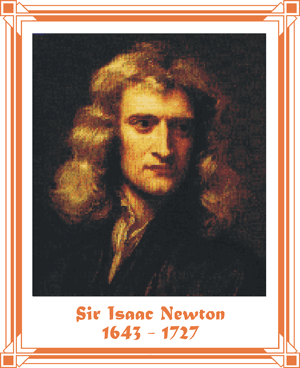 |
The
appearance of Sir
Isaac Newton with
his two greatest works; MATHE- MATICAL
PRINCIPLES
OF NATURAL PHILOSOPHY and OPTICS,
is one of the most important events in the history of science. Newton
not
only employed reductionistic methods, but also created his own
mathematics.
In 1666, Newton investigated the phenomena of light, resolving the
spectrum
of light through his famous and brilliant experiment with the Prism,
and
created the calculus, which later spawned Boolean Algebra
of Logic and the Venn
Diagrams of Set-Mathematics, which this book is based
on.
He then presented his detailed mathematical explanations for the
phe- nomenon
of motion and gravity in 1687.
|
The Prism
and the
Proof for Threefold Constitution of Light.
One of the most
Important Discoveries in History.
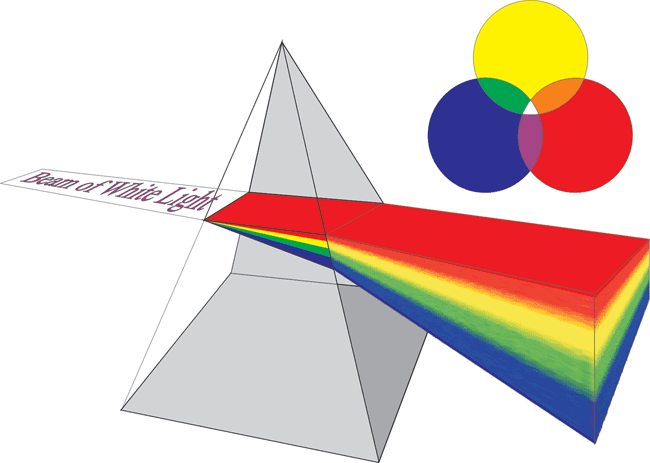 |
Figure 010
In this discovery may be seen the onset of the investigation into the quantum nature of the Universe. Why are the fundamental colors only three? Why are they red, blue and yellow? Why does the blue and yellow mix so distinctly (into green), but not the red and the yellow (orange)? Why are these colors packed together into colorless white light in the photon? These properties of Nature become–along with the particle spin characteristics–one of two prime backbones of the QF-model creation.
Evolution of the Quantum Mechanical New Physics.
It was on the 14th of December 1900 that the New Physics of quantum mechanics were born when Max Plank presented the findings of his investigation into the ultraviolet part of blackbody radiation and solved the enigma of the so-called ultra-violet catastrophe. This was the 397th anniversary of the birthday of Michael de Notredame (1503-1566), the man who is said to have prophesied about the atomic sciences. At the time it was generally assumed that physics could explain everything, only one thing seemed to throw a shadow, but this was the fact that ultraviolet radiation violated the known laws of Nature. Plank’s finding destroyed this believe of Man. With the evolution of the New Physics, or Quantum Physics, Man acquired his second class of Laws of Physics. This is a science that tells us that the material Universe – even Space itself – is composed of energy units whose smallest division is one quanta. The story of its development is one of the more magnificent parts in the history of Man's search for knowledge. Now, at the end of the twentieth century, this science has brought about the possibility for the discovery of Man’s ultimate and final knowledge.
The first two decades of the century would see discoveries of bits and pieces of the quantum puzzle, but it would first be during the twenties and thirties that the science of the New Physics would really emerge. It was Ernest Rutherford, 1st Baron Rutherford of Nelson and Cambridge (1871-1937), who in 1911 established the existence of the atomic nucleus. In 1903, he and Fredrick Soddy (1877-1956) proposed, at the time widely ridiculed, the Nobel explanation for radioactive decay. It would then be Niels Henrik David Bohr (1885-1962), who in 1913, postulated that in an atom, the classical theory would not hold, and that electrons moved in fixed orbits. This created a new model of the atom that agreed with Planck’s discovery of the quanta. The piano virtuoso, Arnold Sommerfeld (1868-1951), would then, in 1915, improve on Bohr’s atom model and introduce the mathematical weak coupling constant 1/137.036 about which Heisenberg would later proclaim; “All the quandaries of quantum mechanics will shrivel up when 137 is finally explained.” Came 1919 and Sir Arthur Stanley Eddington (1882-1944), would produce the first proof for the General Theory of Relativity with photos of bending sunlight, and Rutherford would present the proton.
Evolution of the Quantum Mechanical New Physics.
The thirties would begin by Kurt Gödel (1906-1978) showing the limitations of mathematics in his presentation of The Incompleteness Theorem, and the physicist Carl David Anderson (1905-1991), would experimentally verify the existence of the antimatter positron in 1932 (cosmic-radiation). In the same year, Sir James Chadwick (1891-1974) discovers the neutron (13 years after the proton) and in 1939, Louis W. Alvarez (1911-1988) measures its magnetic momentum. The last two decades of the twentieth century have seen many a marvelous account of the quantum mechanical discoveries of this era and the bizarre descriptions of fundamental reality they brought. The experiences and reactions of the physicists making the discoveries seem to-day humorous, but these were at the time grave trials for the discoverers, who would be fearful of ridicule in discussing what they were discovering. Heisenberg for example gives an account of how he spent a whole night wandering through a public park in Göttingen, contemplating whether it was possible for Nature to be so absurd as it presented itself at the quantum level. Quantum mechanics would force a radical change in the thinking of the physicists. Instead of unifying the known forces, the ever bigger and more powerful accelerators begun in the early thirties, forced the progression of physics into the micro universe of the atom and added two new forces to those known in the twenties. The Weak Interaction (1932), and the Strong Nuclear Force (1935). It would be after 1930 that the science of particle physics began to become established and Fermi would develop a new kind of statistics for explaining the behavior of electrons. He also developed a theory of beta decay and, from 1934 on would investigate the production of artificial radioactivity by bombarding elements with neutrons. Then in 1935 Hideki Yukawa (1907-1981) postulated the existence of the meson as the carrier of the strong nuclear force and in 1938, Otto Hahn (1879-1968), Lise Meitner (1878-1968) and Otto R. Frisch (1904-1979) discovered fission in uranium, announced in 1939. Uranium had been splitting into smaller fragments consisting of lighter elements. During the decade of the thirties, Marie Curie (1867-1934) and Pierre Curie (1859-1906) would do their pioneering work on radioactivity. Linus Carl Pauling (1901-1994) would in 1939 publish ideas for the nature of the chemical bonds in molecules founded in quantum mechanics.
Evolution of the Quantum Mechanical New Physics.
The application of quantum mechanics to the subject of electromagnetic radiation led to explanations of many phenomena, such as “braking radiation”. Pair production or the formation of a positron and an electron when electro-magnetic energy interacts with matter. It also led to a grave problem called the divergence difficulty: Certain parameters, such as the so-called bare mass and bare charge of electrons, appear to be infinite in Dirac’s equations. The terms, bare mass and bare charge, refer to hypothetical electrons–virtual electrons–that do not interact with any matter or radiation. (This phenomenon is being extensively dealt with later in these theorizations, using the term virtual energy of space, or vacuum quantum potential, or the yoga disciplines term, prana.) In reality, electrons interact with their own electric field. This difficulty was partly resolved in 1947-49 in a program called renormalization, developed by the physicists Shin'ichiro Tomonaga (1906-1979), Julian S. Schwinger (1918-1994), Richard Phillips Feynman (1918-1988), and Freeman Dyson (1923- ). In this program, the bare mass and charge of the electron are chosen to be infinite in such a way that other infinite physical quantities are canceled out in the “renormalization” equations. Renormalization greatly increased the accuracy with which the structure of atoms could be calculated from first principles. This would be the completion of the creation of the branch of physics known as Quantum Electro Dynamics (QED). However, when the father of QED, the Nobel laureate Paul Dirac, heard about this, he sternly protested claiming that this meant that something was being swept under the rug. The causes were not investigated and the phenomena not fully explained. There are still existing doubts about this solution. These doubts are parts of the ghosts on the trail of the New Physics. – The electron’s “borrowing” of virtual energy from the surrounding space is something which one physicist, Carl von Weizecker (1912- ), dared to refer to as prana, and claim that Man had access to this energy. All such talk by a physicist would be considered highly irregular and Weizecker became known as the philosophical physicist.
In the year 1953, James D. Watson (1928- ) and Francis Crick (1916-2004) would make a discovery founded in quantum mechanical knowledge. They succeeded in deducing the structure of the code of life, the Double Helix of the DNA. The fifties would see, primarily in association with the nuclear arms race, the building of nuclear reactors and accelerators all over the world. The first atomic fusion-device was detonated on Bikini atoll in the Pacific, in July 1946. – Ever since Rutherford, at the beginning of the century, began his famous experiments by firing alpha particles at thin gold foils, this method has been evolving in the building of ever-larger accelerators, with ever increasing energy. This has been a very successful approach to the solving oft the riddles of physics, but none the less, critic on this method has appeared. This is in the form of metaphors which suggest that this is like someone taking a sledge hammer and with it, granulate grandpa’s watch, then get someone, who had never seen a watch, to investigate the fragments and then tell what they had once been and how they worked together. The critics have pointed out that with the accelerator we are asking Nature questions and that doubts about our interpretation and understanding of Nature’s answers may be in order. The physicists have pointed out that Nature does not deceive us in her replies. That mathematics is a language, which does not permit delusions. However, in spite of the unquestionable and grandiose success of quantum physics, some problems are still associated with our understanding of Nature’s replies. These problems have to do with the limits of mathematics. Professor Stephen Hawking reminded us of this when he said that quantum mechanics is “Basically a theory about something, which we do not know and cannot predict.” Here the reference is to the fact that although we can control the outcome statistically, we do not know what is happening inside the “black box” of the interactions. We only see what goes in and what comes out.
Evolution of the Quantum Mechanical New Physics.
Sir Francis Crick (1916-2004) and Sydney Brenner (1927- ) would, in 1961, explain the genetic code of DNA consisting of strings of non-overlapping base triplet nucleotides. Brian Josephson (1940- ) would discover the Josephson effect. In 1956, the work of Julian Schwinger (1918-1994) had produced two new theoretical bosons called W-negative and W-positive and Steven Weinberg (1933- ) would in 1961 propose a Z-neutral boson. These were theoretical objects involved in a proposed unification theory of the weak-nuclear force and the electro-magnetic force. Separately the physicist Sheldon L. Glashow (1932- ), and together Abdus Salam (1926-1996), and Steven Weinberg (1935- ) would then propose the theoretical unification during the last years of the sixties. The three would then share the Nobel Prize for this in 1979. This came about without experimental proof, but that came in 1983 (see figure 124, page 379). This would present humanity with proof that the electro-magnetic force–whose field-quanta boson is the photon–and the weak-nuclear force–whose field-quanta bosons are the W-negative, W-positive and the Z-neutral–are a manifestation of a force that becomes united at about 100 GeV energy. This is the approximate equivalent of the state of the Big Bang at Second 10-12. The force would logically be christened the electro-weak force and its discovery would reduce the forces of nature to three.
The physicists Murray Gell-Mann (1929- ), in co-operation and independently, with George Zweig and Yuval Ne’eman, made predictions of the inner construction of the nucleons; the Quarks. Quantum entities that possess they’re own spin characteristics, but were endowed with 1/3 fractions of the 1eV charge of the electron. The existence of the quarks would then be confirmed experimentally in 1968. It would, however, not be possible to observe the quark in independent existence and huge amounts of research funds would be spent until physicists would accept the confinement of quarks. That the quarks only enjoy what is known as “asymptotic freedom,” inside the nucleon. Further theoretical and experimental discoveries were made of two generations of higher energy types of unstable quarks in baryons known as Hyperons. This further prompted a race for quark discoveries by the accelerator teams. With the help of these fraction-fractions of atoms, mathematically renormalized and defined in the so-called Quantum Chromo Dynamics (QCD), it became possible to classify all the particles into three families (generations). – These essential discoveries, in particular the unification of the weak and electromagnetic energy exchanges into what now is known as the "Elector-Weak-Theory", is seen by many as a future kind of a fundament to any grand, or complete unified theory of all the forces. With quantum chromo dynamics, this is now the backbone in the so-called “Standard Model”, as the physicists call the present theoretical constructions of the physical Universe. No other theories have enjoyed such general acclaim as these two. Every time new discoveries come from the accelerators, they fit perfectly into the puzzle of the complex picture of the Standard Model. However, in spite of these successes, the models could not tell us which fundamental components are the most fundamental, nor would they sort out the puzzles of quantum reality. Neither would they permit any connection to the Observer, nor explain the meaning of it all. Most of all, the final explanation for the force of gravity–how matter manages to curve space–remained out, but this constituted the marriage of quantum mechanics to general relativity.
Another discovery based on quantum mechanics was made in 1970 as David Baltimore (1938- ) discovers reverse transcript RNA to DNA, and then in 1977, Pierre Chambon and his colleagues would discover that the DNA contained in addition to the protein copying information carrying nucleotides, more than twice as many nucleotides. Molecular biologists would speak of the “junk-genes,” or “genetic-junk,” and the four nucleotide base biochemical letters ACGT molecules would be given the names; Intron Nucleotides for the letters producing the “junk” and Exon Nucleotides for the letters producing the genes. Intron nucleotides are few in prokaryotes, and no purpose has been established in their presence in the DNA of eukaryotes. This still presents a formidable riddle. The insights made during these two decades constitute the backbone information for the QF-theoretical endeavors of which the one by the Hungarian born Dennis Gabor (1900-1979) of Holography is one of the most important ones. In 1971 he received the Nobel Prize for this discovery.
Evolution of the Quantum Mechanical New Physics.
Many different bodies of physicists worked on the superstrings, and in Princeton University, a group of four physicists–humorously named The Princeton String Quartet–under the guidance of David Gross, connected the string theories to other applications of mathematical theoretical physics. These symmetrical equation transformations became quite a curiosity when they in so-called super symmetry equations produced two Universes, not one. Here following we have copied from F. David Peat most interesting 1988 book; SUPERSTRINGS AND THE THEORY OF EVERYTHING, his description of this: “Here the basic symmetry equation, E8 x E8, divides in two, in the Big Bang and creates Two identical Universes, E8 and E8-shadow. We live in our Universe with its planets, stars and galaxies, but according to these ideas, then, parallel to ours, another Universe exists invisible to us, but basically the same! Each Universe has its own electromagnetic force, weak and strong interactions, protons, electrons and neutrinos. These particles can then form atoms out of themselves, later these atoms form molecules. Finally the molecules form rocks, planets, stars and living systems such as theoretical physicists and persons with interest in physics, like the one who is reading this. Still the electromagnetic force and the nuclear force of either one of these Universes will not have any influence in the other. It is as if E8-shadow was indicating an invisible Universe, another World which has a parallel existence to, and which transcends ours. The electrons of the shadow Universe cannot influence the electrons in ours. Protons and shadow protons do not see each other; shadow rocks pass through the walls in our living room. Since the gluons and the electro-weak forces are isolated inside each E8 group, then they cannot create any influence between our world and that of the Shadow-Universe. Still both Universes have their existence within one space/time, and since gravity is a commodity of the whole E8 x E8 symmetry equation, then it remains unchanged through the all breaks in the symmetry and the compactification of dimensions. Gravity connects both Universes. They have their existence within one space/time, which is collectively curved by the mass and energy of both Universes. At this moment we could be sitting in the same chair as someone in the other world. Or, we could be sitting on the bottom of the sea in the shadow-world, or in the middle of shadow-sun.” Here is also F. D. Peat’s most eloquent comment on this; “Physics has finally succeeded in outdoing the science fiction novels.”
By the beginning of the 1990s physicists had produced 5 superstring theories of everything in ten dimensions with different mathematical details, but without any inclusion of the observer. However, the problem with them was that we only have one universe to apply this to. This produced crisis in physics which was solved in 1995 by the super brilliant physics professor, Edward Witten, who produced new concepts in the form of spherical eleven dimensional membranes. This theory was called the M-theory, but it to was without any inclusion or connection to the observer.
The century then ended with the 1980 inauguration Is the End in Sight for Theoretical Physics? lecture prediction of Professor Stephen Hawking that “it is altogether possible that we’ll either become bogged down and have no more progress, or that we’ll soon find the unified theory…” This was then followed by the same bogged down state of the efforts of molecular biology at the completion of the mapping of the 3.200 million nucleotide base biochemical letter human DNA-molecules. This came about through the first years of the new millennium completion of its mapping revealing only 30 to 35.000 genes utilizing only 2,75% of the DNA’s nucleotides, with the rest being unexplained and labeled as introns and none-coding intergentic DNA. Added to this was the unexplained homeostasis of the gene-expressions involving the mysterious functions of the homeotic genes and the spliceosomes molecules.
Well then, we go on to the next chapter which deals with the cutting edge of physics and the physicists' believe that the goal of the final theory is within reach. This is based on the principles of beauty as observed in their superstring and membrane theories, but they are none the less without the Observer. – Well then, it's time we take a closer look at...
The Leading Edge of Science.
Part One,
Chapter
Three
The
Leading Edge
of
Science
The
Search
for the
Final Theory
of the
Universe,
Life and Man
"I would like to know exactly what happened between 10-33 second and 10-43 second. It is there that the ultimate answers to all questions about the universe–life itself included–lies."
Stephen W. Hawking
John D. Barrow
One Global Description of Truth/Reality.
In the last two decades of the 20th century, a realistic hope emerged amongst the physics community that a final theory of the Universe, including Man and his consciousness, was within reach.
During the progression of the sciences there have been those who have condemned Man’s acquisition of scientific knowledge as being something evil. This has been expressed mainly through the idea of the mad scientists. However, the case is rather that of a mad humanity, since it is not our knowledge that is causing us problems. It is rather a question of what we do with our scientific knowledge. It is not Man’s sciences that are the problem, rather; it is Man him-self. The founding masters of Man’s great religions, the great philosophers of past centuries, and in latter times, the masters of physics and psychobiology, have been, and are, addressing the questions of Man, Truth and Reality. Most of the truths or realities of the material Universe are now formulated in the wondrous laws of physics, but the most important subjects, Life and Man himself, have been left outside the realm of these laws.
and the Quest involving the “Cosmic Blueprint”.
During the sixties and the seventies, work on creating Big Bang theories continued, but numerous features needed explanations. One of these was the so-called flatness problem, or the observed homogenetic and isotropic feature of the Universe. The next major break in the creation of Big Bang explanations was Alan Guth’s 1981 introduction for an “inflationary scenario”, in the standard model. These where ideas where the Universe balloons out of primordial cosmic conditions. Questions of the initiation of galactic formations were then solved through the detection–in 1990 by the COBE satellite–of very slight temperature differences in the finally established 2,7o Kelvin cosmic radiation background. This was further evidence for the origin of the Universe in a Big Bang. There are, however, still some puzzling features of the Universe that need an explanation such as the recent Perlmutter suggestions for an accelerating Universe (page 28). The question of the actual age of the Universe is one enigma whose answer keeps wandering about with the appearance and disappearance of evidence that change the so called Hubble constant. This tends to produce astronomical phenomena that seem older than the Universe. Another major enigma is the so-called “dark matter”. Jan Hendrik Oort (1900-1992) and Fritz Zwicky (1898-1974 had presented in the thirties evidence for much greater mass in the galaxies than indicated by the visible burning baryonic matter in the suns. In the 80s it was shown that as much as 90 to 99% of the galactic matter has to be invisible. A recently added feature to the mysteries that need explanation are the bubble shaped voids–100 to 400 million light years across between walls of galaxy formations–in the large scale distribution of matter in the Universe.
The Meaning of the Ultimate Theory of Everything.
*) Perhaps there is not any recipe for the Universe. The question; Why? could end in a never-ending question. The ultimate truth of the Universe could be founded in pure coincidences.
*) Man's ability to understand could be too limited in order to understand the recipe for the Universe. Certainly, a dog will never be capable of understanding quantum mechanics.
*) It is possible that the physicists will in the end have to satisfy themselves with the Anthropic Principle, which is a sort of easy escape for God through the back door. This rule says that the Universe is as it is because it is the only Universe where Men exist and can ask the question; Why is the Universe as it is?
The Leading Edge of the Objective Sciences.
The Pyramid
of Progression
of Physics Knowledge.
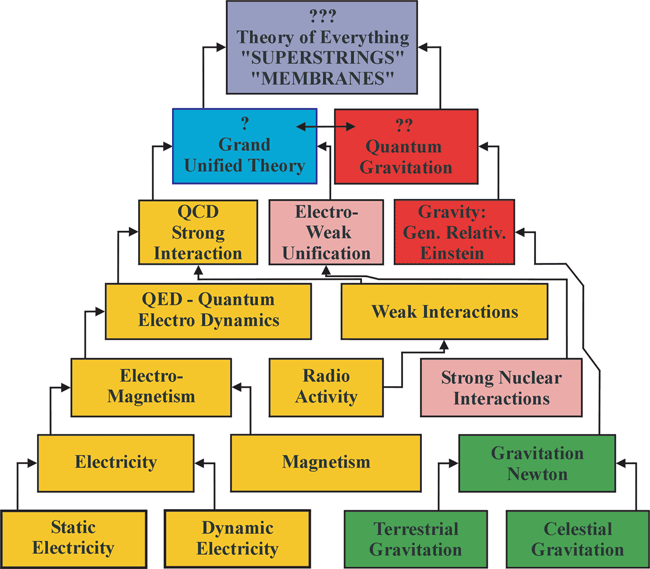 |
The scheme is deliberately constructed into a pyramid-form, in order to conform to the suggestion of Sir Francis Bacon. Bacon saw the knowledge of Man as being structured as a pyramid, with an ultimate top-stone. The top-stone represents the final goal of all the sciences, which in the author’s estimate is the ultimate knowledge of Man. This top-stone is approached by physics via two different routes. One through Big Bang theories and the other through theoretical-experimental work in elementary particle physics.
Route
a). -
Approach
via Big Bang Theorizations:
One approach is
that
of seeking the summit via theorizations around the GUT-era,
in the Big Bang. This is
primarily
limited by the “partial collapse” of the mathematical method around
fraction
10-30
of The
First Second of Creation. At this point the density of
the
Universe is such that most values start approaching infinities and the
mathematics loose their ability to tell us anything. They become
nonsensical.
Route
b). -
Approach
via High-Energy Particle Physics:
The other approach
is via theorization in high-energy particle physics, dealing primarily
with unification of the electro-weak interactions and the strong
interactions.
This is primarily limited by Man’s inability to produce higher energy
accelerators.
The currently available maximum accelerator outputs are limited at
energy
around 1 to 10 TeV. The energy required is around 1012
to 1015
TeV,
which represents a huge gap (See page 17).
QF-Approach to that of physics: Route a).
Comparison
of the
QF-Approach to that of Physics:
Route a)–The
Physics
Approach.
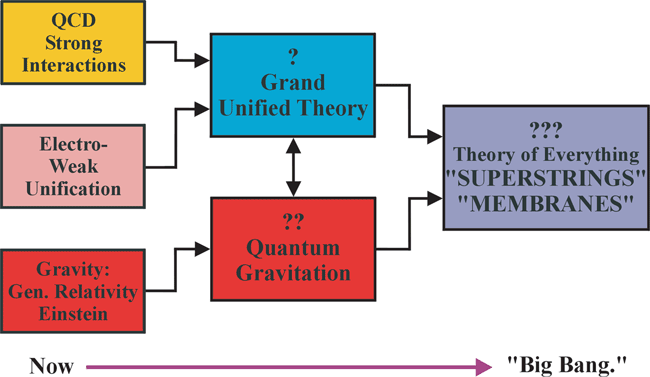 |
Figure 012
The question mark marked boxes in figure 012 represent the final assault on the summit of the mountain of knowledge, as projected by theoretical physics. These theories require a reconciliation of Quantum Mechanics and General Relativity, but mathematical attempts so far have yielded incalculable absurdities, mostly in the form of infinities.
Comparison
of the
QF-Approach to that of Physics:
Route a)–The
QF-Approach.
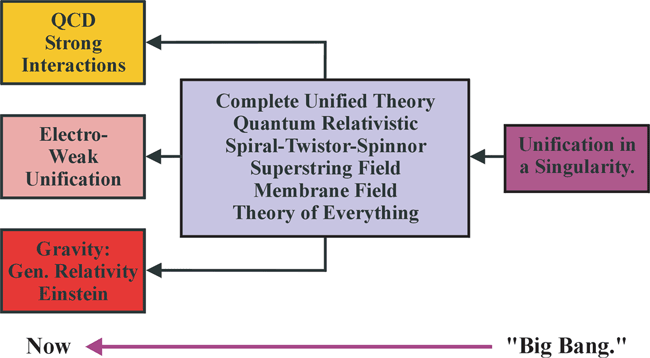 |
Figure 013
Figure 013 represents the equivalent route of the QF-theorizations, and the simplest description possible of the theoretical model of the Big Bang that produces a Complete Unification of forces and which presents–as regards the author of this theory–a satisfactory result for the presentation of a CUT/TOE paradigm. In this they produce the missing answers to the questions regarding the force of gravity in the form of the QF-diagram models, presenting suggestions for the reconciliation of Quantum Mechanics and General Relativity, and additionally bring in the consciousness of Man. It should be noted that the QF-theory does not produce a grand unification.
QF-Approach to that of physics: Route b).
Comparison
of the
QF-Approach to that of Physics:
Route b)–The
High-Energy
Particle Physics.
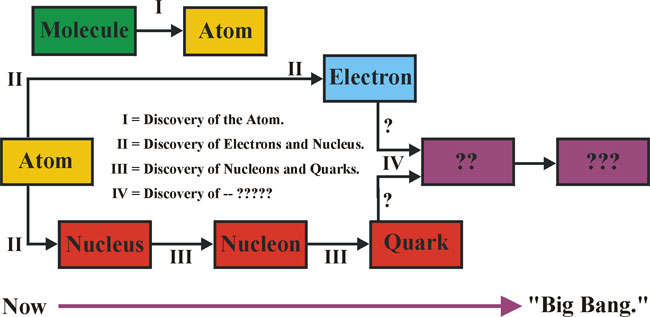 |
Figure 014
The search for the answers to the questions in the question mark marked boxes in figure 014 has brought together cosmology-astrophysics and theoretical physics/high-energy experimental physics. The box with the two question marks represents the unification of the electro-weak force and the strong nuclear force and the three question marks represent the unification of these forces with gravity. This would reveal a Complete Unification Theory (CUT), which in turn may explain the Observers of the Universe through the wave function of the Universe, and thus qualify as a Theory of Everything (TOE). The relationship of the QF-theory to these proceedings is shown in figure 015.
Comparison
of the
QF-Approach
to that of Physics:
Route b)–The
Big
Bang QF-Theorizations.
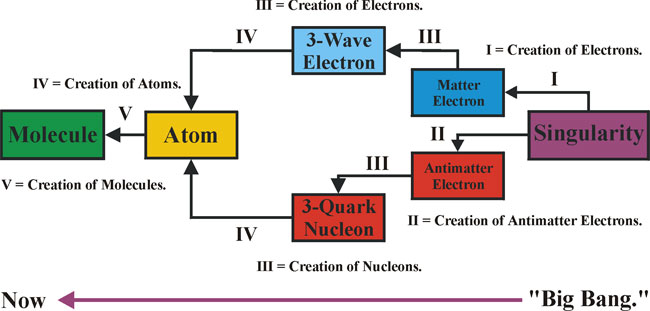 |
Figure 015
This graphic scheme for the QF-models suggestions for the composition of the particle side of the top-stone of the pyramid of knowledge suggests further that one more figure is necessary for this expression.
The Overview
Comparison
QF-Approach for
Route a)
and Route b).
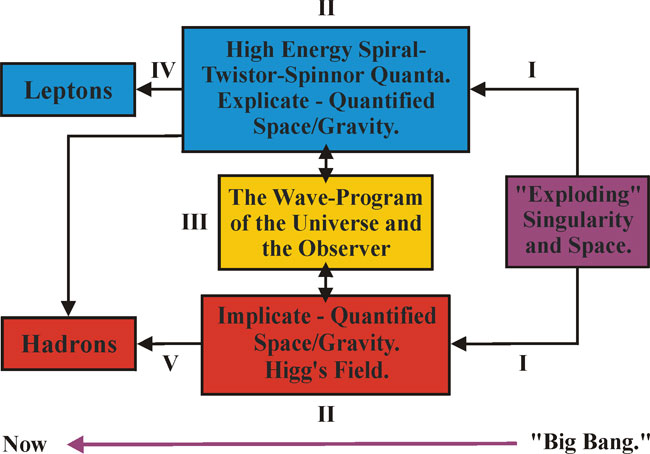 |
Figure 016
The Questions of the Causative Reality and God.
1.
The
Copenhagen
Interpretation.
This is the
interpretation
that most physicists accept and follow. It teaches that the cause for
the
collapse of the wave packet is purely random. The interpretation says
that
the probability is all we can know and all there is to know. Prime
proponent
of this explanation was the prominent Niels Bohr. The
famous
opponent was Albert Einstein who rejected this view with
his famous quip: “God does not play dice
with
the Universe.”
2.
The
Hidden
Variable Theories.
These suggest that
quantum processes are not purely random, and that there are specific
factors
behind the scenes–even none-locally–that collapse the wave packet.
Suggestions
are that eventually the causative factors will be found and controlled
to produce a prediction of the collapse of the wave packet. Famous
proponents: David
Bohm, Albert Einstein and Jack
Sarfatti.
3.
The
Many
Worlds Hypothesis.
In this
explanation
there are several interconnected Universes where the complementary
events
take place. All mutually exclusive possibilities contained in the wave
function do occur, but in different Universes. This theory is proposed
by the prominent: Hugh Everett III, John A.
Wheeler
and A. Graham. This interpretation prompted Fred
Alan
Wolf to write the PARALLEL UNIVERSES
and Francois Mauriac to quip: “What
this is
saying
is far more incredible than what we poor Christians are asked to
believe.”
4.
The
Matter/Mind
Connection.
This
interpretation
comes in many varieties, but its prime contents are that the
measurement
collapses the wave packet (creates the observed event), but
consciousness
triggers the measurement. Thus it is the mind that collapses the wave
packet.
One of the proponents of this interpretation connects the consciousness
to the quantum vacuum potential. Famous advocates: Eugene Wigner,
Jack
Sarfatti, Walker and Muses.
The question of the concept of God in Big Bang theories is something most physicists generally shy away from. None the less the term is commonly used and on the occasion of the publication of his 1988 book, A BRIEF HISTORY OF TIME, Hawking expressed his opinion that it will be possible to explain–in one mathematical equation–all that is observable in creation. His suggestion that the solution would be in mathematics and that he was convinced that: “God spoke that language” is worth repeating here. The prime components of this proposed equation are the unification of general relativity and quantum mechanics, thus the unification of the laws of classical mechanics with the statistical laws of physics.
and the Suggested Connections to Eastern Mysticism.
In 1978 Lawrence Beynam made the following claims: “We are currently undergoing a paradigm shift in science–perhaps the greatest shift of its kind to date. It is for the first time that we have stumbled upon a comprehensive model for mystical experiences, which has the additional advantages of deriving from the forefront of contemporary physics.” Six years later, the grand commentator of mystical phenomena, Ken Wilber, wrote a brilliant critical appraisal of these ideas and called it Physics, Mysticism, and the new Holographic Paradigm. In this, it may be said that he wiped out the hopes of those who saw before them the marriage of mysticism and physics. In this article Wilber paraphrased Master Eckhart: “If your God is the God of today’s physics, then where that physics goes (tomorrow), that God goes with it.” Nonetheless, this model caused some physicists to see connections between their work and the philosophy behind Eastern Mysticism, and the writings of Fritjof Capra: THE TAO OF PHYSICS and Gary Zukav: THE DANCING WU LI MASTERS, became popular. Capra was later quoted expressing the ideas of David Bohm: “Quantum theory forces us to see the universe not as a collection of physical objects, but rather as a unified whole.... All [physical] particles are dynamically composed of one another in a self-consistent way, and in that sense can be said to ‘contain’ one another. In [this theory], the emphasis is on the interaction, or ‘interpenetration’ of all particles.”* Much of the information that follow are taken from John Boslough’s book STEPHEN HAWKING’S UNIVERSE. Written at the beginning of the eighties, it describes how many physicists began to see the paradoxes, the coincidences and the statistical possibilities, as well as the requirement for the observer in quantum mechanics, as having been projected in the writings of Hinduism, Buddhism and Taoism. Quantum Mechanics, they suggested, is just a rediscovery of Shiva or Mahadeva, the triple horned Hindu god of destruction and cosmic solution. Shiva, which is mentioned as early as the third or fourth century before Christ, adopts several forms. One of them is Nataraja, the four-armed lord of the cosmic dance, shown as dancing on a vanquished and flattened devil. The dance of this god is symbolic for the repeated universal creation and destruction. Matter has no form; it is only dynamic, rhythmic gyration of energy coming and going. In continuation of this came the criticism of David Bohm, after he had consulted Krishnamurti and he had become conscious of the limits in the nature of the scientific method. He had become aware that, in his search, the scientist does not turn his attention inward. Bohm’s remark: “The human minds ability to grasp higher realities is denied or ignored by conventional science. Standard science is at a dead end because it analyzes experience into discrete pieces. The human mind–and particularity the mind of the physicist–has an overwhelming need to impose categories on experience. As a result the seamless web of physical reality is divided into separate events that seem to occur only side by side in different parts of time and space.”* By understanding Eastern Mysticism, Bohm suggests that physicists can free their minds, at least briefly, from the self-created prison in order to attain an instant of scientific creation. At Cambridge, Professor Brian Josephson has for some time actively practiced Eastern meditational techniques. He won the Nobel Prize in 1973, but has now as a meditational target the relationship between human intelligence and the world it observes. He believes that with increased understanding of Eastern Mysticism, he will gain insights into objective reality. In 1995 Josephson announced that he was leaving physics in order to pursue a carrier investigating psychic phenomena.
Inclusion in the Ultimate Theories.
The trail of the ghost is to be found in remarkable remarks of many of the physicists. It may be said that Plank himself had this initiated in 1931, when he said: “Science can never solve the enigma of Nature, and this is because that in the final analyzes, we our selves are a part of the puzzle, which we are trying to solve.”* Right at the onset of the evolution of quantum mechanics, the British physicist, Sir James Jeans quipped: “The Universe begins to look more like a great thought than a machine.” The Swiss biologist Adolf Portmann commented on this: “It is known that the natural sciences have arrived at the borders of the physically knowable. They have had to acknowledge an infinite mystical domain behind all life.” The temperamental Nobel laureate, Wolfgang Pauli, did make much fuss about this question and went to see Carl Gustaf Jung in his search for an understanding of the connection between the Observer and the experiment. Later Pauli was quoted: “Behind reality there is an elevated and independent order which both the spirit of the observer, as well as the object of investigation, are subject to.” When David Bohm later spoke to Krishnamurti, he was not the first physicist of the New Physics, who turned to those who investigate the spirit of Man. Their discourse described in the 1985 book THE ENDING OF TIME, ended up dealing with the question: “What happened to humanity? Did we take a wrong turn somewhere on the way?” This same question had already been asked 18 years prior in one of the twentieth centuries most thought provoking writings; Arthur Koestler’s brilliant book THE GHOST IN THE MACHINE. In the preface to that book we find this remarkable statement: “They reflect the streak of insanity which runs through the history of our species, and which indicate that somewhere along the line of its ascent to prominence something has gone wrong... The search for the cause of that deficiency starts with the Book of Genesis and has continued ever since.” In that book Dr. Koestler makes us painfully aware of the truth regarding the fatal “poverty” of our pseudo sciences of psychology and psychiatry. The other side of the coin is the possibility that our clinging to the failed and erroneous theories and methods in this branch of the scientific effort may be keeping us from discovering the real truth of Man.
Without necessarily being aware that something crucial is missing in Man’s pathologically imperfect pseudo sciences of Man, many physicists were aware of the fact that in quantum mechanical observations, the Observer Connection was missing. Here the physicist Brandon Carter reminds us that: “According to the basic laws of physics, we have to include the characteristics of the instruments. Here, we the observer, must be counted amongst the instruments.” And the grand old man of physics, John A. Wheeler, has here commented: “Nothing is more important about quantum physics than this: it has destroyed the concept of the world as ‘sitting out there’. The universe will never afterwards be the same.” In spite of many attempts at including the Observer in the experimental analyzes, this has not met with success. There has not even been anything, which could be classified as close to some kind of success. Appropriately Professor Stephen Hawking remarks: “Although we know the basic equations which bring together all of our biology, we have not been able to bring together any investigation of human behavior into the branch of applied mathematics.”* The physicist and Nobel laureate, Eugene Wigner, has claimed that: “Man will never understand physical reality unless he takes into account the self-reflecting properties of his consciousness.”* Francis of Assisi had described these difficulties thus: “Who is it that does the knowing? – What we are seeking is that which is seeking.”*George Berkeley bishop is known for remarks of this nature. What is here the foundation for the declaration of the physicists, is the hope of finding the “program” for the wave function of the Universe. That would then represent the “program” for all wave functions, as well as the wave function of the human brain. This is so, since all wave functions are of the same quantum mechanical nature.
A consequence of all this is the suggestion that we cannot close this discussion without having the famous psychobiologist, Richard M. Restak, saying few words. At the opening of his 1979 book THE BRAIN, THE LAST FRONTIER he provides us with this information: “Two former Nobel Prize laureates in physics were recently asked to guess what area of research would win the Nobel Prize for physics in the year 2000. Both of them, without prior consultation and with hardly a hesitation, said brain research. The human brain, they concluded, is our ultimate intellectual challenge in the last quarter of the twentieth century.” Restak declares the search for the final understanding of consciousness and the functions of the human brain, to be “The final frontier of science.”*
The Overview of the References.

